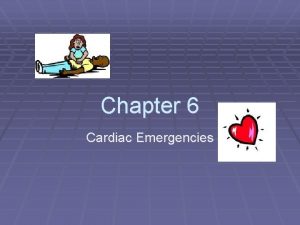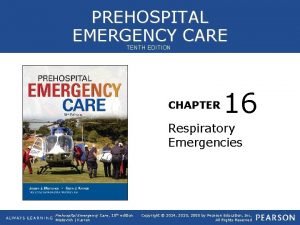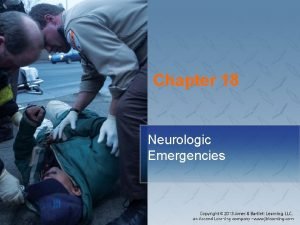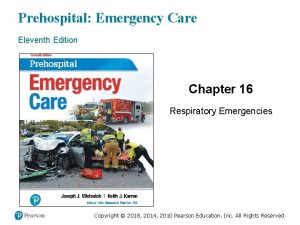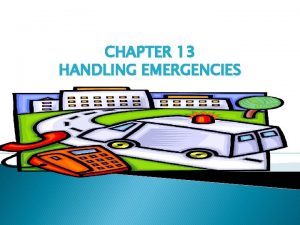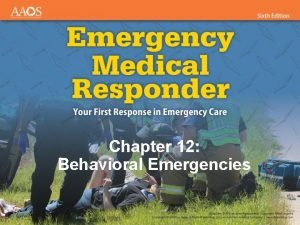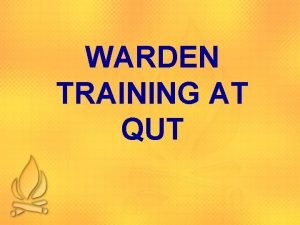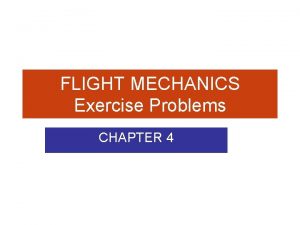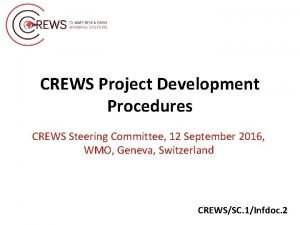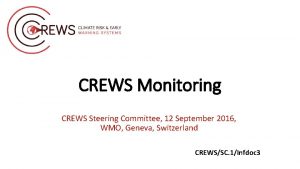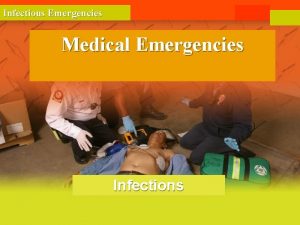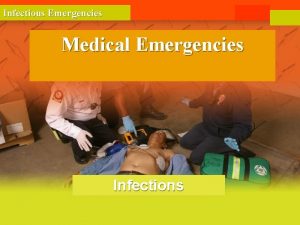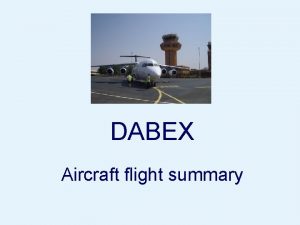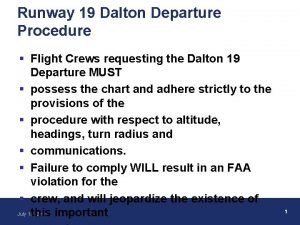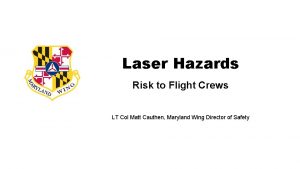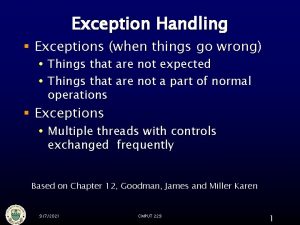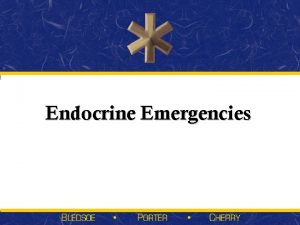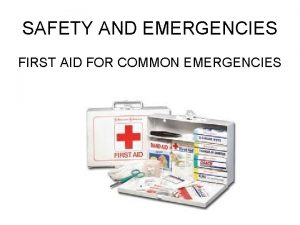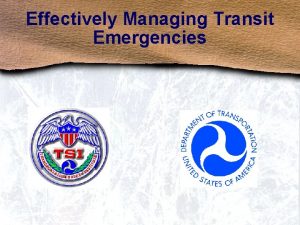When Things Go Wrong Flight Crews and Emergencies




































- Slides: 36

When Things Go Wrong: Flight Crews and Emergencies Barbara Burian, Ph. D. , FRAe. S NASA Ames Research Center Human Systems Integration Division The Emergency and Abnormal Situations study was funded through NASA’s former Aviation Safety and Security Program.

Emergency and Abnormal Checklists Boeing 777 ECL NORMAL MENU RESETS NON-NORMAL MENU FIRE ENG R Fire is detected in the right engine. RIGHT AUTOTHROTTLE ARM SWITCH. . 1. . OFF RIGHT THRUST LEVER. . . . . CLOSE RIGHT FUEL CONTROL SWITCH. . . CUTOFF 2 RIGHT ENGINE FIRE SWITCH. . . . PULL. . . 3 ROTATE If FIRE ENG R message remains displayed: Rotate to the stop and hold for 1 second. NORMA L ITEM OVRD NOTE S CHKL OVRD CHKL RESE T

Checklists and Procedures Checklist Design Human Systems Integration Division Checklist Content

Checklist Design Factors (Paper, Electronic, EFB) Physical Properties and Interface - size, weight, materials, integration w/displays Typography and use of Symbology - font, font size, boldface, intuitive symbology Layout, Format, Organization - visual look, arrangement, “white” space Purpose - fix, troubleshoot, manage situation, guide CRM Objective (of checklist item) - direct action, inform, assess, make decision Length and Workload - physical length, timing length, workload Nomenclature & Abbreviations - terms, labels, abbreviations Language, Grammar, & Wording - English? , verb tense, reading difficulty, clarity, orientation/perspective, directiveness Level of Detail - amount of information provided Engineering Completeness - all necessary steps included Engineering Coherence - order of steps/timing makes “sense” to aircraft Logical Coherence - order of actions makes sense to the pilot and make “sense” operationally Progression & Checklist Navigation - movement within & between checklists/manuals Access - finding correct checklist, prime real estate pgs.

Checklists and Procedures Checklist Design Checklist Content Context Human Systems Integration Division

Pack Trip • Master Caution Alert sounds • Crew Identifies that Pack has tripped off • Crew completes 4 step procedure • Flight proceeds normally Human Systems Integration Division

Value. Jet 592 - In-flight Fire Florida Everglades May 11, 1996 14: 09 Takeoff 14: 10: 03 [chirping sound] “’bout to lose a bus” 14: 10: 15 “Got an electrical problem” 14: 10: 20 “We’re losing everything” 14: 10: 22 “We need to go back to Miami 14: 10: 25 “Fire, fire, fire!” (from cabin) 14: 10: 32 “Uh, 592 needs immediate return to Miami” (to ATC) 14: 13: 43 CVR stops recording 14: 14 Valu. Jet 592 disappears from radar

Checklists Procedures Manuals Level of time criticality Degree of threat Degree of novelty, ambiguity, complexity Amount of increase in workload Requirements of the Emergency or Abnormal Situation

Checklists Procedures Manuals SOPs Regulations Different phases of flight Weather, terrain, etc. Operational Requirements of the Emergency or Abnormal Situation

Requirements of the specific malfunction History of false warnings Checklists Procedures Manuals Warning systems and alerts Appropriate level of automation Automated aircraft systems Flight protection envelopes Flight deck ergonomics Aircraft and Systems Operational Requirements of the Emergency or Abnormal Situation

Manufacturer philosophies Company philosophies and policies Types of checklists available (electronic, paper) Checklists Procedures Manuals Philosophy of checklist use and functionality of electronic checklists Cost-benefit tradeoffs, e. g. , diversions Updates and revisions Philosophies and Economic Constraints Aircraft and Systems Operational Requirements of the Emergency or Abnormal Situation

Checklists and Procedures Checklist Design Checklist Content Context Human Performance Capabilities Human Systems Integration Division

Checklists Procedures Manuals Working, long term, and prospective memory Mental computations Judgment and decision making Visual and auditory processing Philosophies and Economic Attention Constraints Dealing with interruptions & distractions Situational awareness Aircraft and Systems Ability to shift mental sets Motor skills Operational Requirements. Affective responses to stress Requirements of the Emergency or Abnormal Situation Human Performance Capabilities and Limitations under High Stress and Workload

Human Performance under Stress Well-learned motor skills • remain robust and relatively unaffected by stress Our simulator training really paid off. This was my first engine shutdown in 20 years of flying and it felt like I had done it a thousand times before! (ASRS Report, Accession #466167) Human Systems Integration Division

Human Performance under Stress Tunneling • narrowing of human attention • restricts scanning of environmental cues • narrow focus on most salient or threatening cues • yields poor differential diagnosis of situation Working Memory • capacity and length of time information can be held decreases • when exceeded – difficulty performing mental calculations, problem solving, making sense of disparate pieces of information, shifting mental sets (concurrent task management) Tendency to Rush Human Systems Integration Division

Human Performance under Stress We did find communication difficult and the use of oxygen masks, intercom, trying to talk to ATC was a handful. At night made it that much harder to read/accomplish checklist items. Turning cockpit lights on sooner would have helped. (ASRS Report, Accession #472755) Human Systems Integration Division

Checklists and Procedures Checklist Design Checklist Content Context Human Performance Capabilities How Checklists are Used

Checklists and Procedures: Context and Human Performance Considerations Example: Saudi Arabian Flight 163, August 19, 1980 Crew searched unsuccessfully for several minutes for a cargo fire checklist in the Abnormal section of the QRH. The checklist they were looking for, but never found, was in the Emergency section of the QRH instead. Human Systems Integration Division

Checklists and Procedures: Context and Human Performance Considerations Example: Six Different Checklist Titles for the Same Condition – B 737 no flap, no slat All Flaps Up Landing Flaps – All Flap and LED Up Landing No Flap/No Slat Landing Symmetrical Non-Normal Trailing Edge Flaps or No Flaps No Trailing Edge Flaps Alternate Flaps Operation Human Systems Integration Division

Checklists and Procedures: Context and Human Performance Considerations Example: Pilots routinely make errors in correctly recalling “memory items” Air Carrier/Manuf. N of CL with MI Total N of MI Action Conditional Note Other Item MI MI A Classic 23 120 93 21 3 3 B Classic 4 15 13 1 0 1 C Classic 16 112 73 16 21 2 D Classic 5 17 15 2 0 0 Boeing Classic 16 113 73 16 22 2 E NG 9 20 17 3 0 0 F NG 3 11 10 1 0 0 G NG 12 45 37 5 2 1 H NG 10 44 35 5 2 2 Boeing NG 18 129 83 19 24 3 Boe. NG – Rev. 13 77 52 10 14 1

Checklists and Procedures: Context and Human Performance Considerations Example: Applying multipliers to landing distances 1. 7 1. 55 1. 8 1. 35 1. 15 Human Systems Integration Division

Checklists and Procedures: Context and Human Performance Considerations Example: Information missing from checklist – Valujet 558, Jan. 7, 1996 Pull cbs Reset cbs The missing information was included in the AOM expanded checklists but was never transferred to the QRH checklists. AOM

Checklists and Procedures: Context and Human Performance Considerations Example: Confusing and complex wording If Pack Fault due to low bleed air supply, then a bleed leak does not exist, and if WING ANTI-ICE is not required: If Pack Fault due to low bleed air supply, and if a bleed leak does not exist, and if WING ANTIICE is not required: Human Systems Integration Division

Checklists and Procedures: Context and Human Performance Considerations Example: Crew confusion – Fed. Ex 1406, September 5, 1996 FE was confused by step 5 and did not complete steps 6 and 7 Items Pertaining to Adjusting Cabin Altitude or Flight Level Human Systems Integration Division

Start Example: Complex Navigation

Checklists and Procedures: Context and Human Performance Considerations Example: Checklist actions cause another abnormal situation to occur Accomplishing the [immediate action] item for cockpit/cabin smoke on the ground in the XXX aircraft induces the abnormal procedure of equipment overheat due to the step of the turning off left and right recirculation fans, the left recirculation fan being the primary equipment cooling on the ground. (ASRS Report, Accession #473359) Human Systems Integration Division

Checklists and Procedures: Context and Human Performance Considerations Example: Checklist actions not appropriate for situation Hydraulic caution light illuminated while taxiing…I completed the QRH checklist…We rolled to a stop in the grass…A very poorly written QRH emergency checklist. CALLBACK: …The checklist is for use inflight, not on the ground. (ASRS Report, Accession #437817) Human Systems Integration Division

Checklists and Procedures: Context and Human Performance Considerations Example: Swissair 111, Sept. 2, 1998 Human Systems Integration Division

Checklists and Procedures: Context and Human Performance Considerations Example: Swissair 111, September 2, 1998 - continued If smoke/fumes are Time needed for completion not of the two checklists: eliminated, land Approximately 30 minutes at nearest suitable airport Time from first abnormal odor until Swissair 111 crashed in the ocean: 20 minutes, 40 seconds Human Systems Integration Division

Human Performance and Context in Emergency and Abnormal Checklists The Good News: Emergency and Abnormal Checklists and Procedures • can be written to address the multiple contexts in which emergency and abnormal situations occur • can be designed to accommodate many human performance limitations that occur under high stress and high workload Human Systems Integration Division

Addressing Context in Emergency and Abnormal Checklists To Ensure that Context is Addressed: • Make sure checklists are designed for full range of the scenarios for which they will be used (e. g. , pressurization: slow leak – to – explosive/rapid decompression) • Make sure checklists are appropriate for all phases of flight and aircraft configurations for which they may be used (e. g. , on ground, in-flight, throttles at idle) • Make sure checklists address relevant environmental conditions (e. g. , icing) and loss of pertinent equipment that has been MEL’ed. • Conduct a realistic timing assessment of crucial checklists and procedures (length of completion). • Conduct a realistic workload assessment of checklists and procedures, especially when conducted during various phases of flight. Human Systems Integration Division

Addressing Human Performance under Stress in Emergency and Abnormal Checklists To Ensure that Tunneling is Addressed: • Draw crew attention to environmental or situational cues that support diagnosis • Draw crew attention to environmental or situational cues that contraindicate diagnosis • Cues specified must be ones that flight crews are able to assess Human Systems Integration Division

Addressing Human Performance under Stress in Emergency and Abnormal Checklists To Ensure that Working Memory Limitations are Addressed: • Provide information or resources (e. g. , EFB) to diminish/eliminate memory load and need to perform mental calculations • Place remaining “memory items” on quick reference cards/QRH cover (paper and unannunciated electronic checklists) • Integrate all needed information (tables, normal checklists) with emergency and abnormal checklists – “get in, stay in” • Make sure all checklists are complete and ramification of crucial steps is provided (before the step is to be carried out) • Provide “purpose of item” and “purpose of checklist” statements • Provide information describing aircraft performance limitations • Provide information describing remaining aircraft capabilities • However, don’t go overboard with providing so much information that checklists take forever to go through/read

Barbara Burian, Ph. D. bburian@mail. arc. nasa. gov Emergency and Abnormal Situations Study http: //human-factors. arc. nasa. gov/eas Human Systems Integration Division

The Context in Which Emergency and Abnormal Situations Occur Aloha 243 Explosive Decompression Jet. Blue 292 Air Canada 797 Misaligned Nosegear In-flight Fire

In-flight Smoke, Fire, Fumes Integrated Checklist Courtesy of United Airlines
 Iambic pentameter
Iambic pentameter Crews middle school staff
Crews middle school staff Alexis crews
Alexis crews Amanda crews
Amanda crews Flight flight freeze fawn
Flight flight freeze fawn Its human sign
Its human sign Lesson 6: cardiac emergencies and using an aed
Lesson 6: cardiac emergencies and using an aed Endocrine and hematologic emergencies
Endocrine and hematologic emergencies Emt chapter 18 gastrointestinal and urologic emergencies
Emt chapter 18 gastrointestinal and urologic emergencies Chapter 28 lesson 1
Chapter 28 lesson 1 I can prevent most surface emergencies (problems) by
I can prevent most surface emergencies (problems) by Chapter 16 respiratory emergencies
Chapter 16 respiratory emergencies Major nutritional deficiency diseases in emergencies
Major nutritional deficiency diseases in emergencies Environmental emergencies emt
Environmental emergencies emt Chapter 23 gynecologic emergencies
Chapter 23 gynecologic emergencies The term behavioral crisis is most accurately defined as
The term behavioral crisis is most accurately defined as Chapter 18 neurologic emergencies
Chapter 18 neurologic emergencies Chapter 16 respiratory emergencies
Chapter 16 respiratory emergencies Pumberton sign
Pumberton sign Gems diamond geriatric
Gems diamond geriatric Chapter 13 handling emergencies
Chapter 13 handling emergencies Chapter 12 behavioral emergencies
Chapter 12 behavioral emergencies Chapter 32 environmental emergencies
Chapter 32 environmental emergencies Chapter 16 cardiovascular emergencies
Chapter 16 cardiovascular emergencies Psychiatric emergency
Psychiatric emergency Qut security emergency extension number
Qut security emergency extension number Immunologic emergencies
Immunologic emergencies A 41 year old man presents with slow irregular breathing
A 41 year old man presents with slow irregular breathing Whats an energy pyramid
Whats an energy pyramid Movement
Movement Motivation based on ideas of right and wrong
Motivation based on ideas of right and wrong The distinction between right and wrong lies at the
The distinction between right and wrong lies at the Example of ethics
Example of ethics Ethics discovering right and wrong
Ethics discovering right and wrong N
N Speed tunnel
Speed tunnel Equation for drag
Equation for drag






